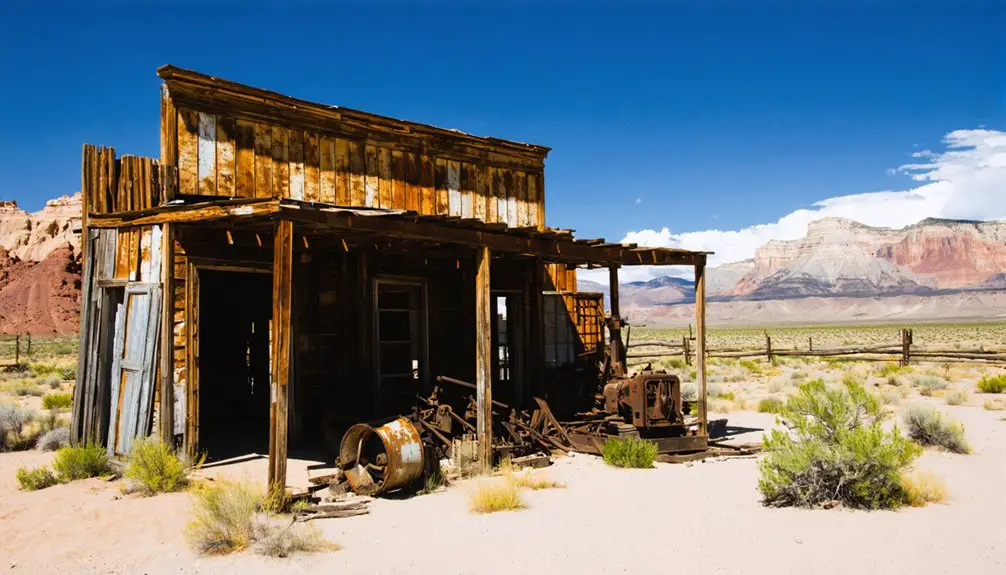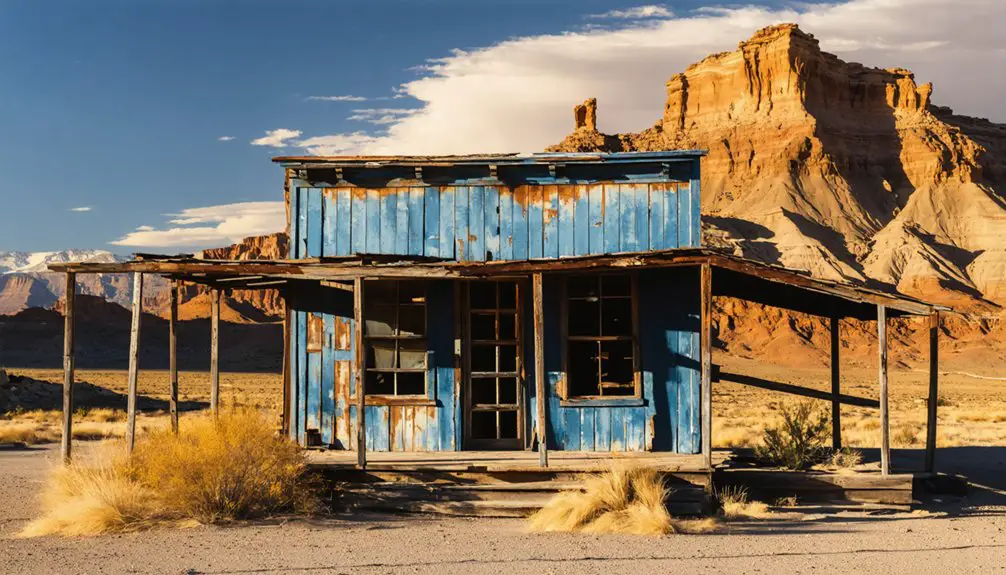You’ll find Aragonite ghost town‘s weathered ruins 2.8 miles south of I-80 Exit 56 in Utah’s Tooele County. This early 1900s mining settlement operated briefly using basic tools before depleting its resources and falling into abandonment. Today, you can explore scattered foundations, an old truck, and the remains of a bunkhouse amid the desert landscape. While most structures have vanished, the site’s rich mineral legacy and mining heritage beckon curious adventurers to uncover its secrets.
Key Takeaways
- Aragonite was a brief early 1900s mining settlement in Utah that operated using basic manual tools before becoming a ghost town.
- The site is accessible via Interstate 80 Exit 56, located 2.8 miles south of Safety-Kleen facility in Tooele County.
- Only weathered ruins of a bunkhouse, scattered foundations, and an old truck remain at the coordinates 40.724846° N, 112.941124° W.
- The area contained valuable mineral deposits including aragonite and silica, as documented in Utah Geological Survey Bulletin 117.
- Visitors should bring safety gear, travel with companions, and respect historical artifacts while exploring the remote desert location.
A Mining Town’s Brief Rise and Fall
While the western United States experienced a surge in demand for construction materials in the early 1900s, the remote site of Aragonite, Utah emerged as a specialized mining operation focused on extracting its namesake mineral.
You’ll find that mining techniques at Aragonite were fairly basic, relying on manual tools like picks and shovels to excavate both surface quarries and underground shafts.
Workers lived on-site in a brick bunkhouse and smaller buildings, as the location’s isolation required immediate housing. Despite its historical connection to pioneer routes like the Hastings Cutoff, the town remained underdeveloped beyond essential mining infrastructure.
Life in isolated Aragonite centered around simple worker housing, never growing beyond the basic needs of its mining operations.
Within just a few years, operations ceased completely, and Aragonite began its transformation into a ghost town. Today, only the bullet-riddled brick bunkhouse stands as a testament to the town’s mining past.
The abandoned site now features collapsed mine shafts, deteriorating structures, and scattered evidence of its brief but industrious past. Today, visitors often report that few visible structures remain at the site, though careful observation can reveal building foundations.
Finding Your Way to Aragonite
To reach the ghost town of Aragonite, you’ll need to take Interstate 80 to Exit 56 in western Utah’s Tooele County.
From there, drive south about 2.8 miles on the paved road that passes the Safety-Kleen facility. Your route planning should include a vehicle with good clearance, as you’ll then turn onto a dirt road heading east for roughly 3.6 miles to find the old bunkhouse remains.
For reliable navigational aids, use these GPS coordinates: 40.724846° N, 112.941124° W.
You’ll find yourself in a remote desert basin at 5,030 feet elevation, surrounded by the Cedar Mountains to the south and Grassy Mountains to the north. The area follows the historic Hastings Cutoff route once used by pioneer travelers. While some visitors report that visible structures are limited, careful observation may reveal historical foundations.
Be mindful of restricted military areas nearby, and don’t count on finding amenities – bring what you need.
What Remains Today
Although most of Aragonite’s original structures have vanished over time, you’ll still find the weathered ruins of a bunkhouse and a smaller adjacent building at the former townsite.
These remaining structures stand as silent witnesses to the town’s historical significance as a mining outpost. Like many abandoned mining camps across Utah, the site offers opportunities for careful exploration. Careful observation reveals scattered foundations throughout the area. You’ll notice several unstable mineshafts from the original aragonite mining operations, though they’re dangerous to approach.
An old truck from the early 20th century remains on site, providing a tangible connection to the mining era.
The rest of the townsite has largely returned to its natural desert state, with only scattered foundations and mining equipment marking where buildings once stood.
Time and desert winds have reclaimed this once-bustling mining town, leaving only concrete footprints and rusted remnants behind.
No intact commercial or residential buildings have survived the harsh desert conditions and decades of vandalism.
Mining Legacy and Mineral Wealth
You’ll find Aragonite’s mining history reflects a brief but significant chapter in Utah’s early 20th-century industrial development.
Located in the Cedar Mountains District of Tooele County, the site exemplifies the area’s historical mining operations.
Though the aragonite mining operations lasted only a few years, they represent the region’s diverse mineral wealth, which included not just decorative aragonite but also valuable silica deposits.
The site’s shift from an active mining camp to a ghost town mirrors many other short-lived mining ventures in Tooele County, where economic priorities and resource depletion led to eventual abandonment.
The area was extensively documented in Bulletin 117 by the Utah Geological and Mineral Survey, providing detailed insights into its mineralogical significance.
Mining’s Short-Lived Glory
When prospectors discovered aragonite and silica deposits in early 1900s Utah, they established the mining town of Aragonite at an elevation of 5,200 feet in Tooele County.
While Utah’s mining industry was experiencing tremendous growth with 32 mining districts by 1871, Aragonite’s economic factors weren’t as favorable as other booming sites like Bingham Canyon.
The region was part of a vast network of 116,000 western mines documented in historical mineral resources data.
You’ll find that Aragonite’s historical significance was brief but remarkable. The town’s mining operations lasted only a few years, hampered by limited infrastructure and processing capabilities.
Despite Utah’s broader mining success with silver, gold, and copper exports worth millions, Aragonite’s modest mineral wealth couldn’t sustain long-term operations.
The UGS’s metallic resources data provides detailed insights into the area’s mineral composition and mining history.
Today, only abandoned mineshafts and deteriorating bunkhouses remain, evidence of the town’s short-lived mining glory.
Aragonite’s Industrial Heritage
The geological richness of Aragonite extended beyond its short-lived mining operations. You’ll find evidence of diverse mineral wealth in the area’s industrial archaeology, from aragonite veins used in decorative building stone to silica deposits in the nearby sand dunes.
The region’s elevation of 5,200 feet in Tooele County created unique geological conditions that supported various mining ventures.
As mineral exploration expanded in the early 1900s, you could’ve witnessed underground shafts and open quarries dotting the landscape, though primitive technology limited their success.
While the mines’ remote location ultimately restricted long-term viability, they played an essential role in Utah’s broader industrial mineral boom.
Today, the area’s legacy lives on through its shift to modern industrial use, including the Aragonite Hazardous Waste Incinerator.
Safety Tips for Ghost Town Explorers

Exploring ghost towns requires careful preparation and attention to safety protocols before setting foot in these fascinating yet potentially hazardous sites.
You’ll need essential safety gear including sturdy boots, gloves, and an N95 respirator to protect against hazardous materials like asbestos and mold. Never explore alone – bring at least two companions and guarantee someone outside your group knows your plans.
Before visiting Aragonite, verify legal access and obtain necessary permissions to avoid trespassing issues.
Follow proper exploration etiquette by carrying multiple light sources, first aid supplies, and navigation tools. Always assess structural stability before entering buildings, watching for unstable floors and ceilings.
Remember to preserve the site’s historical integrity by not removing artifacts or creating new paths. Stay alert, move carefully, and maintain clear communication with your group throughout your visit.
Modern Industry Meets Historical Remnants
Modern industry has dramatically transformed Aragonite’s landscape since its early 1900s origins as a mineral mining settlement.
When mining operations ceased in the mid-20th century, the town fell into abandonment, with most buildings succumbing to destruction and vandalism.
You’ll now find a stark contrast between old and new at the site. The 1991 construction of Utah’s first hazardous waste incinerator, now operated by Clean Harbors, stands adjacent to the deteriorating ghost town remnants.
While ghost town exploration remains possible, you’ll need to navigate carefully around collapsed mine shafts, bullet-riddled structures, and industrial preservation challenges.
The facility’s presence has complicated access to historical areas, though roadside markers still acknowledge the site’s mining heritage.
This unique intersection showcases how modern industrial development has reshaped this once-thriving mining community.
Frequently Asked Questions
Are There Any Documented Deaths or Accidents From the Mining Operations?
You won’t find specific documented deaths or accident reports from Aragonite’s mining operations. While early 1900s mining safety was generally poor, no clear records exist of casualties at this site.
What Was the Peak Population of Aragonite During Its Mining Heyday?
You’ll find no exact records, but based on the mining techniques and limited bunkhouse capacity, peak population likely didn’t exceed 100 people. Today, only ghost stories remain of those workers.
Were There Any Notable Conflicts Between Miners and Native American Tribes?
You won’t find documented evidence of mining disputes or tribal relations at this site. Historical records show no notable conflicts between miners and Native Americans during Aragonite’s brief operational period.
Did Any Famous Historical Figures Pass Through or Visit Aragonite?
Like a blank page in history’s book, you won’t find any famous visitors or historical figures passing through Aragonite. The town’s remote location and brief mining history kept it far from celebrity paths.
Were There Schools, Churches, or Other Community Buildings Besides Mining Facilities?
You won’t find any schools, churches, or social gathering spots at Aragonite – it was strictly a mining operation with basic worker housing. Community infrastructure never developed beyond the essential mining facilities.
References
- http://www.expeditionutah.com/forum/index.php?threads/ghost-town-aragonite-tooele-county-utah.378/
- https://jacobbarlow.com/2019/07/06/aragonite-utah/
- https://en.wikipedia.org/wiki/Aragonite_Hazardous_Waste_Incinerator
- https://jacobbarlow.com/tag/ghost-towns/page/3/
- https://www.ghosttowns.com/states/ut/aragonite.html
- https://www.youtube.com/watch?v=_Q_MurSaRyM
- https://historytogo.utah.gov/mining/
- https://wrcc.dri.edu/cgi-bin/wea_info.pl?utARAG
- https://www.mindat.org/feature-5770821.html
- https://www.instagram.com/reel/DNYXOfMpAPX/



